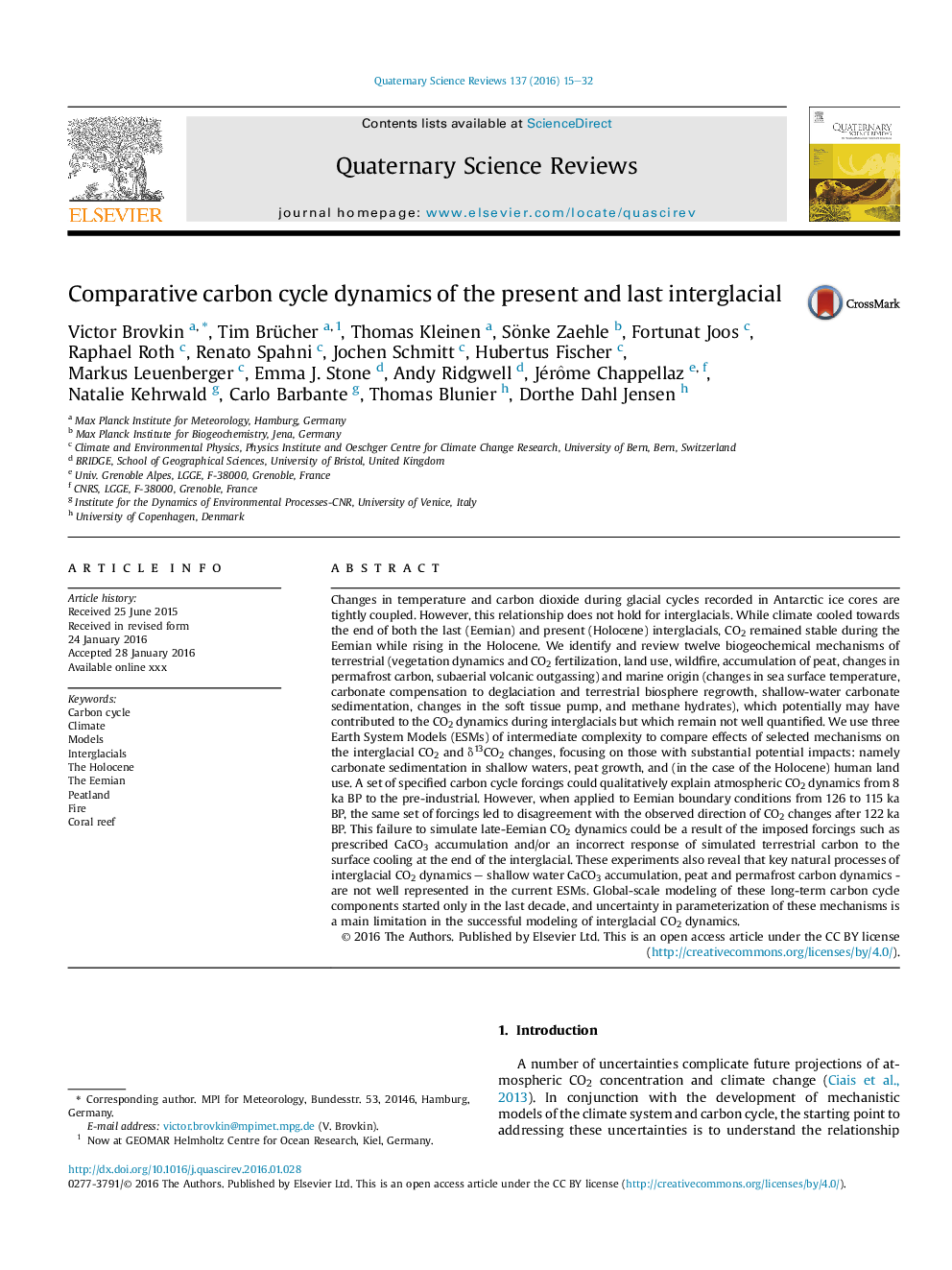| کد مقاله | کد نشریه | سال انتشار | مقاله انگلیسی | نسخه تمام متن |
|---|---|---|---|---|
| 6446503 | 1640798 | 2016 | 18 صفحه PDF | دانلود رایگان |
عنوان انگلیسی مقاله ISI
Comparative carbon cycle dynamics of the present and last interglacial
ترجمه فارسی عنوان
دینامیک چرخه کربن تطبیقی درونی و بینظیر گذشته
دانلود مقاله + سفارش ترجمه
دانلود مقاله ISI انگلیسی
رایگان برای ایرانیان
کلمات کلیدی
موضوعات مرتبط
مهندسی و علوم پایه
علوم زمین و سیارات
زمین شناسی
چکیده انگلیسی
Changes in temperature and carbon dioxide during glacial cycles recorded in Antarctic ice cores are tightly coupled. However, this relationship does not hold for interglacials. While climate cooled towards the end of both the last (Eemian) and present (Holocene) interglacials, CO2 remained stable during the Eemian while rising in the Holocene. We identify and review twelve biogeochemical mechanisms of terrestrial (vegetation dynamics and CO2 fertilization, land use, wildfire, accumulation of peat, changes in permafrost carbon, subaerial volcanic outgassing) and marine origin (changes in sea surface temperature, carbonate compensation to deglaciation and terrestrial biosphere regrowth, shallow-water carbonate sedimentation, changes in the soft tissue pump, and methane hydrates), which potentially may have contributed to the CO2 dynamics during interglacials but which remain not well quantified. We use three Earth System Models (ESMs) of intermediate complexity to compare effects of selected mechanisms on the interglacial CO2 and δ13CO2 changes, focusing on those with substantial potential impacts: namely carbonate sedimentation in shallow waters, peat growth, and (in the case of the Holocene) human land use. A set of specified carbon cycle forcings could qualitatively explain atmospheric CO2 dynamics from 8 ka BP to the pre-industrial. However, when applied to Eemian boundary conditions from 126 to 115 ka BP, the same set of forcings led to disagreement with the observed direction of CO2 changes after 122 ka BP. This failure to simulate late-Eemian CO2 dynamics could be a result of the imposed forcings such as prescribed CaCO3 accumulation and/or an incorrect response of simulated terrestrial carbon to the surface cooling at the end of the interglacial. These experiments also reveal that key natural processes of interglacial CO2 dynamics - shallow water CaCO3 accumulation, peat and permafrost carbon dynamics - are not well represented in the current ESMs. Global-scale modeling of these long-term carbon cycle components started only in the last decade, and uncertainty in parameterization of these mechanisms is a main limitation in the successful modeling of interglacial CO2 dynamics.
ناشر
Database: Elsevier - ScienceDirect (ساینس دایرکت)
Journal: Quaternary Science Reviews - Volume 137, 1 April 2016, Pages 15-32
Journal: Quaternary Science Reviews - Volume 137, 1 April 2016, Pages 15-32
نویسندگان
Victor Brovkin, Tim Brücher, Thomas Kleinen, Sönke Zaehle, Fortunat Joos, Raphael Roth, Renato Spahni, Jochen Schmitt, Hubertus Fischer, Markus Leuenberger, Emma J. Stone, Andy Ridgwell, Jérôme Chappellaz, Natalie Kehrwald, Carlo Barbante,
